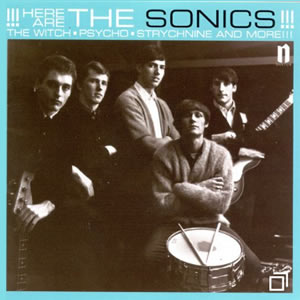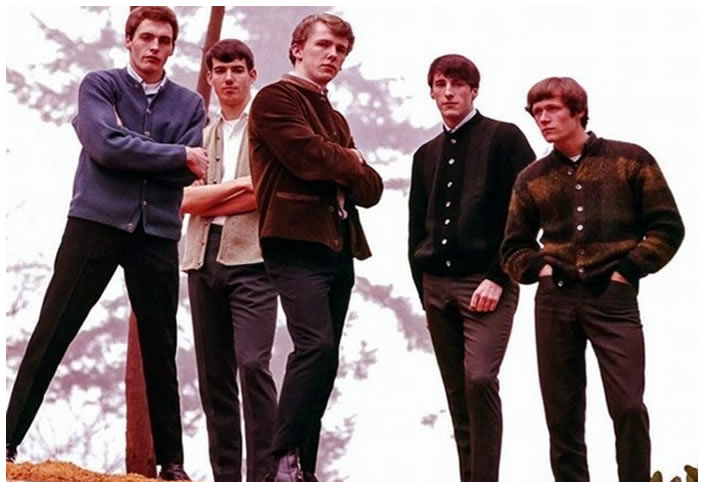Here Are the Sonics!!!
 Here Are The Sonics!!! is the 1965 debut album by American garage rock band The Sonics. The record features a dozen songs of the days’ most powerful and upbeat rock with some flourishes into shocking and unpolished blues with none of these densely packed tracks eclipsing more than three minutes in length. With this studio recording, the group finely captured their live blend of covers and a few originals while at the peak their power, making it one of the earliest influences of the soon-to-come punk rock genre.
Here Are The Sonics!!! is the 1965 debut album by American garage rock band The Sonics. The record features a dozen songs of the days’ most powerful and upbeat rock with some flourishes into shocking and unpolished blues with none of these densely packed tracks eclipsing more than three minutes in length. With this studio recording, the group finely captured their live blend of covers and a few originals while at the peak their power, making it one of the earliest influences of the soon-to-come punk rock genre.
The Sonics were formed in 1960 in Tacoma, Washington by then-teenage guitarist and vocalist Larry Parypa. About a year later, Larry’s brother Andy Parypa joined on bass with three members form another band called The Searchers – keyboardist and vocalist Gerry Roslie saxophonist Rob Lind and drummer Bob Bennett – coming along in 1963. The group developed a sound based around simple chord progressions, speed and tonal aggression, and their live repertoire began to pick up speed in the Seattle area through 1964 with the groups internal goal being to “move the floor and break windows.”
Buck Ormsby, contemporary bassist for the Northwest band the Wailers, signed to his bands’ independent label Etiquette Records and assumed the producer for their debut album. The songs were recorded with a limited number of mics, giving into a highly energetic, lo-fi live feel. Prior to the album’s release, the single “The Witch” was released. Written by Roslie, this original track which would lead off the album featured a doomy riff of combined sax, guitar and organ with Larry Parypa’s strained vocals giving the song an edge which made it ahead of its time. Through airplay on smaller radio stations in the Northwest, and became one of the largest selling independent singles in the region.
 Here Are the Sonics!!! by The Sonics |
|
|---|---|
| Released: March, 1965 (Etiquette) Produced by: Buck Ormsby & Kent Morrill Recorded: Audio Recording, Seattle, 1964 |
|
| Side One | Side Two |
| The Witch Do You Love Me Roll Over Beethoven Boss Hoss Dirty Robber Have Love Will Travel |
Psycho Money (That’s What I Want) Walking the Dog Night Time Is the Right Time Strychnine Good Golly Miss Molly |
| Group Musicians | |
| Gerry Roslie – Lead Vocals, Piano, Organ Larry Parypa – Guitars, Vocals Rob Lind – Saxophone, Harmonica, Vocals Andy Parypa – Bass Bob Bennett – Drums |
|
Following the popular opener comes a pair of covers. Berry Gordy Jr’s “Do You Love Me” is pretty close to original but with slightly differing backing vocals, while Chuck Berry’s “Roll Over Beethoven” is an original interpretation with dual lead vocals and some fine guitar riffing. Roslie’s “Boss Hoss” is the album’s second original, with this steady rocker driven by the consistent beat of Bennett and a nice growling sax lead by Lind.
“Dirty Robber” as a song Ormsby brought with him from the Wailers, followed by the side one closer, “Have Love Will Travel”. Perhaps the album’s most catchy tune, this Richard Berry cover features great riffing and rhythms backing a real showcase for Roslie’s lead vocals. The second side features two originals that appear to be about alcohol and drug abuse, the horror screed “Psycho” and “Strychnine”, the dark, piano-led “ode to poison” rocker with a nice space for instrumentals in between the verses.

The rest of the second side features a mix of contemporary cover songs. “Money (That’s What I Want)” is the first place where the group seems reserved as this version is calmer (and therefore duller) then the excellent John-Lennon led Beatles version from two years earlier. Rufus Thomas’ “Walking the Dog” offers a nice change of pace as a bluesy rock cover, while Roslie fully exhibits his vocal abilities on Lew Herman’s “Night Time Is the Right Time”. This all leads to the apparently logical closer, “Good Golly Miss Molly”, as Roslie fuly pays homage to his idol Little Richard with a nice piano lead adding to the overall effect.
While Here Are the Sonics!!! was not a tremendous commercial success, its influence reverberated through the music industry for more than a decade after its release. The group released a follow-up album, Boom, in early 1966, but by the end of that year their heyday began to diminish.
~
Part of Classic Rock Review’s celebration of 1965 albums.




